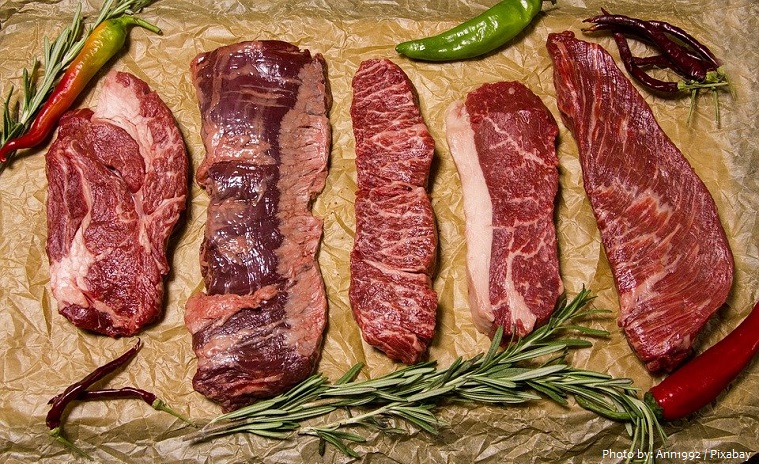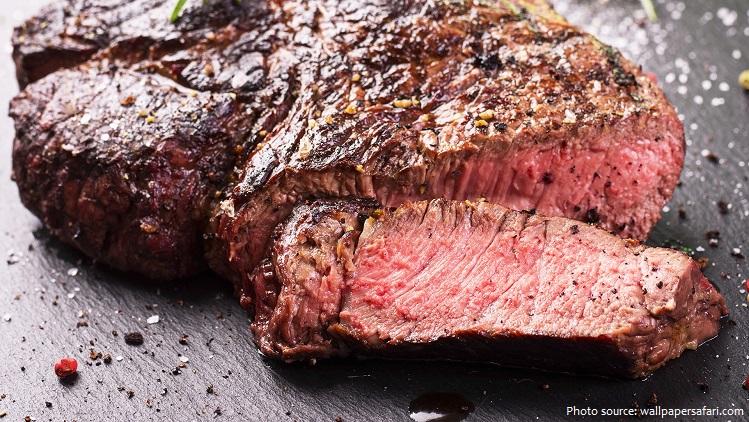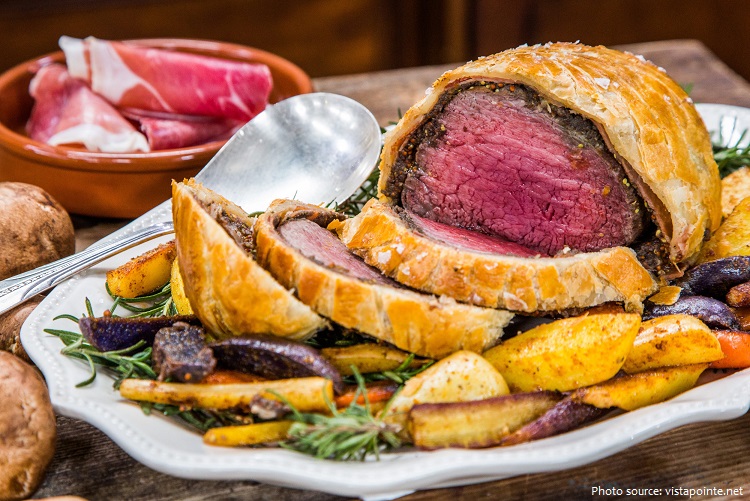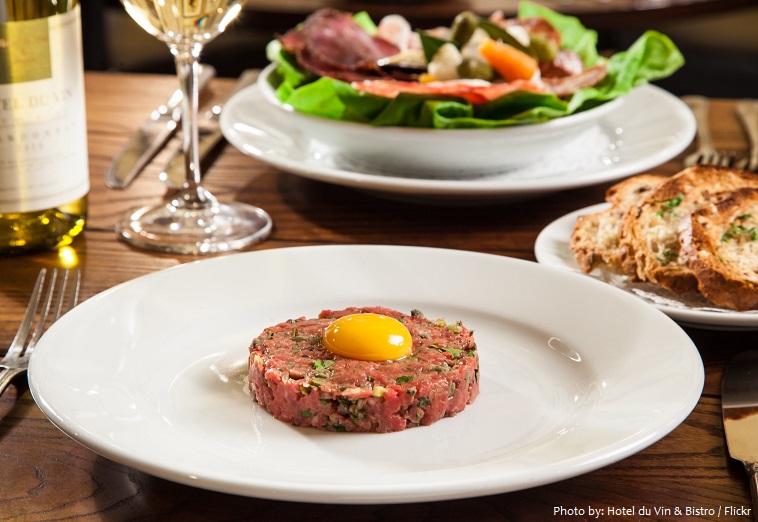Beef is the culinary name for meat from cattle, particularly skeletal muscle.
High-quality beef has firm, velvety, fine-grained lean, bright red in colour and well-marbled. The fat is smooth, creamy white, and well distributed. In young beef the bones are soft, porous, and red – the less desirable mature beef has hard white bones.
Beef tenderness and flavour are improved by aging – in one common aging method the carcass is hung for about two weeks at approximately 2 °C (36 °F), encouraging physical changes in the muscle tissue that enhance the quality of the meat.
Most beef skeletal muscle meat can be used as is by merely cutting into certain parts, such as roasts, short ribs or steak, while other cuts are processed. Trimmings, on the other hand, which are
usually mixed with meat from older, leaner cattle, are ground, minced or used in sausages.
Beef is the 3rd most widely consumed meat in the world, accounting for about 25% of meat production worldwide, after pork and poultry at 38% and 30% respectively.
In absolute numbers, the United States, Brazil, and the People’s Republic of China are the world’s three largest consumers of beef – Uruguay, however, has the highest beef and veal consumption per capita, followed by Argentina and Brazil.
“Beef” is a Middle English word derived from the Latin word bos, meaning cow. According to the Dictionary of Word Origins by John Ayto, “like mutton, pork, and veal, beef was introduced by the Normans to provide dainty alternatives to the bare animal names ox, cow, etc. when referring to their meat.”
Beef has been a staple meat eaten around the world for millennia, dating back as far as prehistory.
Cattle originated in the Old World, having been domesticated around 8000 BC when the material gains from the livestock became apparent.
It is difficult to estimate the precise point where beef became a cooked delicacy, although it probably shortly followed the domestication of cattle.
Following this, people were able to identify specific breeds suited to being used for their meat or dairy produce such as milk and cheese.
In the United States, the growth of the beef business was largely due to expansion in the Southwest. Upon the acquisition of grasslands through the Mexican–American War of 1848, and later the expulsion of the Plains Indians from this region and the Midwest, the American livestock industry began, starting primarily with the taming of wild longhorn cattle. Chicago and New York City were the first to benefit from these developments in their stockyards and in their meat markets.
While the superior beef breed is a matter of debate and personal preference, there is much to be made of the quality of Japanese beef, which many associate with a sense of prestige. The two most notable meats are Wagyu and Kobe, the latter being particularly notable. While Japanese cattle has its origins in China, the breeding innovations are wholly their own. Kobe Beef is the best known, a delicacy renowned for its flavour and texture. Kobe and several other kinds of Japanese beef are imported throughout the world, vaunted by many for their quality.
Beef is a source of protein and nutrients.
There are many interesting and famous beef dishes.
Beef Wellington is an English pie made of fillet steak coated with pâté (often pâté de foie gras) and duxelles, which is then wrapped in Parma ham and puff pastry, then baked. Some recipes include wrapping the coated meat in a crêpe to retain the moisture and prevent it from making the pastry soggy.
Steak tartare is a French dish made from finely chopped or ground (minced) raw meat (often beef). More accurately, it is scraped so as not to let even the slightest of the sinew fat get into the
scraped meat. It is often served with onions, capers, seasonings such as fresh ground pepper and Worcestershire sauce, and sometimes raw egg yolk.
Goulash is usually prepared from beef. The origins of goulash have been traced to the 9th century, to stews eaten by Magyar shepherds. Before setting out with their flocks, they prepared a portable stock of food by slowly cooking cut-up meats with onions and other flavourings until the liquids had been absorbed. The stew was then dried in the sun and packed into bags made of sheep’s stomachs. At mealtime, water was added to a portion of the meat to reconstitute it into a stew or soup.
Bresaola is an air-dried, salted beef that has been aged about two to three months until it becomes hard and a dark red, almost purple, colour. It is lean, has a sweet, musty smell and is tender. It
originated in Valtellina, a valley in the Alps of northern Italy‘s Lombardy region.
Beef jerky is dried, salted, smoked beef popular in the United States. The word “jerky” derives from the Quechua word ch’arki which means “dried, salted meat”. All that is needed to produce basic “jerky” is a low-temperature drying method, and salt to inhibit bacterial growth.
Spiced beef is a cured and salted joint of round, topside, or silverside, traditionally served at Christmas in Ireland. It is a form of salt beef, cured with spices and saltpetre, intended to be
boiled or broiled in Guinness or a similar stout, and then optionally roasted for a period after.
Beef has an abundance of nutrients like B-vitamins, zinc, iron and protein. Among the many delicious benefits you get from enjoying beef, one of the most remarkable is its role in supporting health.







